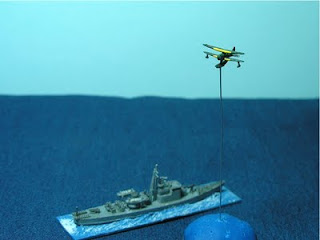Rather than spending time working on my stuff, I spent part of yesterday helping my friend Kevin playtest his Battle of Sluys scenario for Enfilade. we were joined in the playtest, by Mark and Joe Waddington. You can read more about Kevin's work on this project on his
blog and just click the "cogs" label to see the whole story.
 |
| The English and French Fleets square off at Sluys. |
Kevin is using David Manley's Quick Play Medieval Fleet rules for the game and yesterday was the first chance to test out the ships, terrain, and rules. The rules are somewhat like DBA, in that a turn consists of one side rolling for command points, allocating them by formation, moving, and then conducting combat (artillery, missile, and close combat) followed by the other side doing the same. Overall, pretty easy to understand, but with enough decisions to keep players in the game.
We set up the forces, with Mark and Kevin as the English and Joe and I playing the French. The French set-up in the middle of the channel between the mainland and an island. We also started the game chained together and can't unchain until 3 turns after the first French ship takes damage, so there really wasn't a lot to do for the first few turns but wait. Joe ran the French front line, while I took the third squadron in the back, which was a mix of mercenary galleys and medium cogs.
 |
| The initial setup for the French fleet. |
Before the start of the game, Kevin sprang a little surprise on us. He told us that overnight the French fleet had drifted toward the island on our right. So, all the sudden there was a big gap on our left flank. The English moved up with two groups to engage the French front squadron with artillery and later missile fire, while the third group tried to move through the gap on the French left. Unfortunately for them one of their cogs kept running aground in the shallows, forcing the group to stop before pushing ahead.
 |
| The fleets locked in battle as an English squadron tries to move through the gap (at the top of the picture). |
This delay allowed time for my third squadron to unchain and move to block the gap. I was able to defeat the first group of English cogs in close combat.
 |
| My galleys plug the flank gap. |
Then I pushed on into the flanking squadron taking out the squadron commander.
 |
| The galleys counterattack! |
This was the schedule time for the Flemish fleet of small cogs to appear in the French rear. However, by this time things weren't looking good for the English and the Flemish had to sail into the wind to reach the French line. We stopped the game, ate some pizza, and talked about potential changes for the scenario. Kevin took a few notes and after he sorts things out, I expect we will give it another play through.
In addition to seeing Kevin's cogs, I got a chance to look at ships Mark is scratchbuilding. It was around a year ago that Mark was thinking about scratchbuilding some ships for the Great Lakes during the War of 1812. I think he was originally planning to do the ships for the Battle of Lake Champlain, but I talked him into working on ships for Lake Ontario. He has been cursing my name ever since, but the ships look really nice. They are 1/600 scale from wood, with metal masts, and I'm looking forward to getting a chance to play with them.
 |
| Mark's Lake Ontario War of 1812 ships. |



























